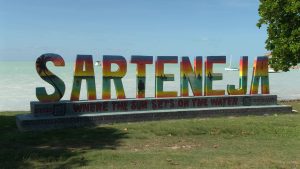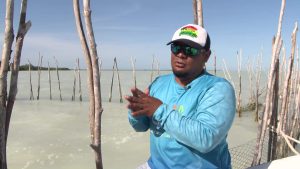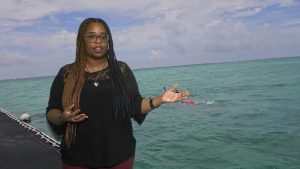How Conservation Is Powering Belize’s Tourism Through Eco-Adventures
If you ask any Belizean what the biggest industry in Belize is, it’s likely that tourism will be their answer. It’s one of Belize’s highest revenue generating industries, contributing to nearly half of the nation’s gross domestic product. But there’s another sector playing a crucial role in keeping the tourism industry alive, conservation. By ensuring that the attractions that draw tourists to Belize are preserved, it creates a sustainable and long-lasting industry. Tonight, we will take you to the Corozal Bay Wildlife Sanctuary where the Sarteneja Alliance for Conservation and Development is combining conservation and tourism with its eco-adventure tours. In collaboration with the Belize Fund for a Sustainable Future, News Five’s Britney Gordon takes you on a journey where the river meets the sea.
 Britney Gordon, Reporting
Britney Gordon, Reporting
In Sarteneja, a picturesque village in northern Belize, life has always revolved around the sea. For generations, the ocean has been more than just a backdrop, it’s been the lifeline of the community. In fact, about 80 percent of the men here earn their living from fishing, making Sarteneja one of Belize’s largest fishing hubs. But now, that same deep connection to the water is opening new doors. Thanks to Corozal Bay EcoAdventures, the spirit of the sea is creating fresh waves of opportunity, transforming tradition into sustainable tourism and innovation.

Diveana Samos
Diveana Samos, Business Manager, Sarteneja Alliance for Conservation & Dev.
“One of our goals is like to promote conservation actions that benefit both biodiversity and people. So what that means is not only the NJO will win when it comes to like our expedition running and everything, we want to support the community members because we believe that if the community wins, our ecosystem will win as well.”
 The Corozal Bay Nature Sanctuary covers approximately one hundred and seventy-eight thousand acres and is home to marine mammals like manatees and dolphins, numerous fish species and the country’s only bull shark nursery. To support its conservation initiatives, Sarteneja Alliance for Conservation and Development created the RIOReef Expedition. It is founded on partnerships with local fishers, artisans, and families to promote sustainable tourism initiatives. One of the first stops on the tour is a visit to a traditional beach trap, which is a tunnel shaped fishing apparatus made from sticks or stones. Head Ranger, Jamayel Verde, tells us how local fishers work with the NGO balance livelihood with conservation.
The Corozal Bay Nature Sanctuary covers approximately one hundred and seventy-eight thousand acres and is home to marine mammals like manatees and dolphins, numerous fish species and the country’s only bull shark nursery. To support its conservation initiatives, Sarteneja Alliance for Conservation and Development created the RIOReef Expedition. It is founded on partnerships with local fishers, artisans, and families to promote sustainable tourism initiatives. One of the first stops on the tour is a visit to a traditional beach trap, which is a tunnel shaped fishing apparatus made from sticks or stones. Head Ranger, Jamayel Verde, tells us how local fishers work with the NGO balance livelihood with conservation.

Jamayel Verde
Jamayel Verde, Head Ranger, Sarteneja Alliance
“That is where sustainability and conservation works hand in hand. Due to the hard work that certain alliance do and the strong communication that we have with the features, they have already adapted to this process whereby if they find a protected species on their harvest. Guess what? They will release that.”
 A significant portion of the income earned through RioReef is used to support the NGO’s local partners while the remaining funds are reinvested in conservation and management programs, ensuring that every dollar contributes to protecting the ecosystems that sustain them. But the valuable work they do cannot be accomplished alone. That’s where the Belize Fund makes a difference. With grant support, the alliance can grow its impact and launch new conservation programs, keeping Belize’s natural heritage thriving for generations to come. It’s one way that the Belize Fund is working to keep conservation alive in Belize.
A significant portion of the income earned through RioReef is used to support the NGO’s local partners while the remaining funds are reinvested in conservation and management programs, ensuring that every dollar contributes to protecting the ecosystems that sustain them. But the valuable work they do cannot be accomplished alone. That’s where the Belize Fund makes a difference. With grant support, the alliance can grow its impact and launch new conservation programs, keeping Belize’s natural heritage thriving for generations to come. It’s one way that the Belize Fund is working to keep conservation alive in Belize.
 Diveana Samos
Diveana Samos
“The title of the grant that we received was safeguarding both biodiversity mechanisms within Corozal Bay Wildlife Sanctuary. So this is this helps us with research and monitoring, going out into the field, doing water quality monitoring, doing bird surveys, doing aerial manatee surveys. As mentioned earlier in the tour, we have one of the highest or highest populations of manatees within the area.”
Traveling along the New River, that is where visitors witness the interconnection between rivers, mangroves and coral reefs. This mangrove ecosystem is one of the healthiest in the country, with some growing up to fifty feet tall.
 Jamayel Verde
Jamayel Verde
“The river, the bay and the reef connection is that, all the impurities that run through the river to the bay, are absorbed by the mangroves. They serve as a filter. And then the Corozal Bay, the sea grass beds that lie within it, they also play their part in cleaning these impurities. And that will help us when, nutrients reach to the reef.”
 History meets nature at the Cerros Mayan temple. Now here’s a fascinating stop on the tour, an ancient temple that researchers believe may have once served as a sacrificial site and even a bustling trade center, thanks to its strategic location. It’s a powerful reminder that when we protect our ecosystems, we’re also preserving history, identity, and the cultural pride woven into these sacred spaces.
History meets nature at the Cerros Mayan temple. Now here’s a fascinating stop on the tour, an ancient temple that researchers believe may have once served as a sacrificial site and even a bustling trade center, thanks to its strategic location. It’s a powerful reminder that when we protect our ecosystems, we’re also preserving history, identity, and the cultural pride woven into these sacred spaces.
Jamayel Verde
“How do we know that this was a treading center? Because traces of obsidian. jade were found here. Now obsidian is just found on areas of where there is volcanic activity. Up to what I know Belize has no volcanoes. So that gives us a hint on the activities that were being done here at Cerros.”
 The expedition also brings community conservation to life just off the coast of Sarteneja, at a special spot called Warrie Bight. Here, visitors can roll up their sleeves and participate in mangrove planting, contributing directly to coastal restoration and resilience.
The expedition also brings community conservation to life just off the coast of Sarteneja, at a special spot called Warrie Bight. Here, visitors can roll up their sleeves and participate in mangrove planting, contributing directly to coastal restoration and resilience.
 Diveana Samos
Diveana Samos
“One of the things we try to do, especially in this pier where I am at right now. Once we get on the boat and we go move backwards, you will see that the mangroves cover all the building. And one of our goals is to show different developers that we can protect mangroves. You can protect the ecosystem at the same time and having something nice and pretty to just sit and relax on.”
The expedition concludes where freshwater meets the Caribbean Sea at the Bacalar Chico Marine Reserve. Whether visitors choose to snorkel through the reef or explore Mayan structures, this station highlights how research, education, and conservation come together to safeguard the reef. Every experience strengthens the connection between the community and nature with the goal to unleash nature, inspire minds and embrace thrills. Britney Gordon for News Five.






Facebook Comments